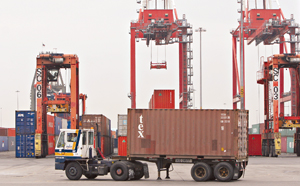Chassis Pool to Aid Cargo Flows Being Developed at N.Y., N.J. Port

This story appears in the March 23 print edition of Transport Topics.
A new chassis pool for the Port of New York and New Jersey meant to improve truckers’ equipment utilization and enhance cargo flow remains on track to start in the third quarter, a top regional official said.
John Nardi, president of the New York Shipping Association, told Transport Topics last week that a so-called market pool was being created, which would allow truckers to use multiple providers’ chassis to move containers on and off the docks of the five terminals that make up the complex.
“My hope is that this market pool will be the most cost-effective pool and will attract users as such,” said Nardi, whose group negotiates labor contracts for ocean carriers and terminal operators. “All of the current intermodal equipment providers will participate in the pool.”
Chassis owners TRAC Intermodal, Flexi-Van Corp. and Direct ChassisLink, which already have cooperated on a Southern California chassis pool, are working on the details of how the New York-New Jersey operation would be structured, sources said.
Truckers had various reactions.
“I’d like to have it in place today — the sooner the better,” drayage operator Tom Adamski said. “It would take off the pressure and improve utilization.”
Adamski represents the New Jersey Motor Truck Association on the task force created last year by the Port Authority of New York and New Jersey to upgrade chassis and other dock business activities.
“I know [the pool] is in the works, but we don’t have any formal proposal yet,” said Jeff Bader, who heads the Association of Bi-State Harbor Carriers.
“We don’t know anything yet about what the pool will look like,” Bader told TT, noting that its final form is subject to approval by members of the chassis group that Nardi leads.
Curtis Whalen, executive director of American Trucking Associations’ Intermodal Motor Carrier Conference, said it wasn’t yet clear what the new pool’s structure would be.
“I don’t know what it is anymore — what it is that they have agreed to, and every day gets us closer to third-quarter kickoff,” he said. “There are a lot of things that are swirling around. It confuses the hell out of me.”
In the current environment, truckers usually waste time and money whenever they enter a terminal with one owner’s equipment and have to hunt down a different chassis to meet another customer’s needs.
Currently, there are three primary New York-New Jersey pools, as well as some independent providers, that serve the dock area, but none of them serves all five terminals in the region.
Adamski, who is an agent for trucker First Coast Logistics, explained it is highly unusual for a driver to enter and leave a terminal with a load from the same ocean carrier.
Nardi said, “Draft operating agreements have been circulated and commented upon. Meetings are being scheduled to drill into the details of comments provided.”
The parties also are discussing selection of an outside firm to manage the pool.
“It’s a very positive development that the IEPs have proven that they can implement gray pools in Southern California and the Pacific Northwest,” Nardi said, using an industry term to describe pools that allow truckers to use any pool participant’s equipment. “This shows that ultimately there is a will to implement gray pools by the asset owners.”
Meanwhile, early reports indicated measureable progress in dock operations since the chassis pool on the West Coast began March 1.
The three leasing companies last fall began working on the Southern California pool after receiving Justice Department clearance to proceed.
PierPass, which was formed by terminal operators at Los Angeles and Long Beach, the nation’s two largest ports, to address such issues as congestion, security and air quality, reported that containers moving through the terminals were 46% higher in a two-week early March period than the same 14 days of last month when cargo slowdowns were common.
Truck times spent inside the terminal during daytime hours fell by 19% during this month’s two-week period, compared with February, the group’s statement said.
“The terminals are intensely focused on returning to normal operations as quickly as possible,” John Cushing, president of PierPass, said in a statement.

